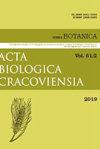Qa-SNARE Protein SYP22 Negatively Regulates Brassinosteroid Signaling in the Dark
IF 0.5
4区 生物学
Q4 PLANT SCIENCES
引用次数: 2
Abstract
Soluble N-ethyl-maleimide sensitive factor attachment adaptor protein receptor (SNARE) domain-containing proteins were mainly involved in vesicle-associated membrane fusion. Genetic screening has revealed the function of SNARE in different aspects of plant biology. Among them, Synthaxin-22 (SYP22) a Qa-SNARE has been reported to have a pleiotropic function in plant development including regulation of leaf waving, shoot gravitropism and flowering time. In this study, we identified a new role of SYP22 in regulation of brassinosteroid (BR) signaling, especially in the dark. SYP22 interacts with BR receptor, brassinosteroid insensitive 1 (BRI1), and overexpression of SYP22 enhanced a weak BRI1 mutant bri1-5 phenotype. syp22 mutant exhibits short hypocotyl and it is sensitive to exogenously treated BR while slightly insensitive to BR-biosynthesis inhibitor propiconazole (PCZ) in the dark. Expression levels of BR signaling maker genes ACS5, SAUR15 and IAA19 were slightly higher, while BR6OX2, a BR biosynthesis marker gene, was lower in syp22 compared to the wild-type. In addition, syp22 was sensitive to 2,4-D, a synthetic auxin, in the dark. In conclusion, SYP22 is involved in BRand auxin-mediated hypocotyl growth inhibition in the dark, which might be via interaction with BR and auxin key regulators to alter their internalization in Arabidopsis.Qa-SNARE蛋白SYP22在黑暗中负调控油菜素内酯信号
可溶性n-乙基马来酰亚胺敏感因子附着接头蛋白受体(SNARE)结构域蛋白主要参与囊泡相关膜融合。基因筛选揭示了SNARE在植物生物学不同方面的功能。其中Synthaxin-22 (SYP22) a Qa-SNARE在植物发育中具有多效性,包括调节叶片摆动、茎向地性和开花时间。在这项研究中,我们发现了SYP22在调控油菜素内酯(BR)信号传导中的新作用,特别是在黑暗中。SYP22与BR受体brassinosteroids insensitive 1 (BRI1)相互作用,SYP22的过表达增强了BRI1突变体BRI1 -5的表型。syp22突变体下胚轴短,对外源处理的BR敏感,而在黑暗中对BR生物合成抑制剂丙环唑(PCZ)略不敏感。与野生型相比,syp22中BR信号制造基因ACS5、SAUR15和IAA19的表达水平略高,BR生物合成标记基因BR6OX2的表达水平较低。此外,syp22在黑暗中对合成生长素2,4- d敏感。综上所述,SYP22参与了BRand生长素介导的黑暗下胚轴生长抑制,这可能是通过与BR和生长素关键调节因子相互作用来改变它们在拟南芥中的内化。
本文章由计算机程序翻译,如有差异,请以英文原文为准。
求助全文
约1分钟内获得全文
求助全文
来源期刊
CiteScore
3.00
自引率
0.00%
发文量
0
审稿时长
>12 weeks
期刊介绍:
ACTA BIOLOGICA CRACOVIENSIA Series Botanica is an English-language journal founded in 1958, devoted to plant anatomy and morphology, cytology, genetics, embryology, tissue culture, physiology, biochemistry, biosystematics, molecular phylogenetics and phylogeography, as well as phytochemistry. It is published twice a year.

 求助内容:
求助内容: 应助结果提醒方式:
应助结果提醒方式:


